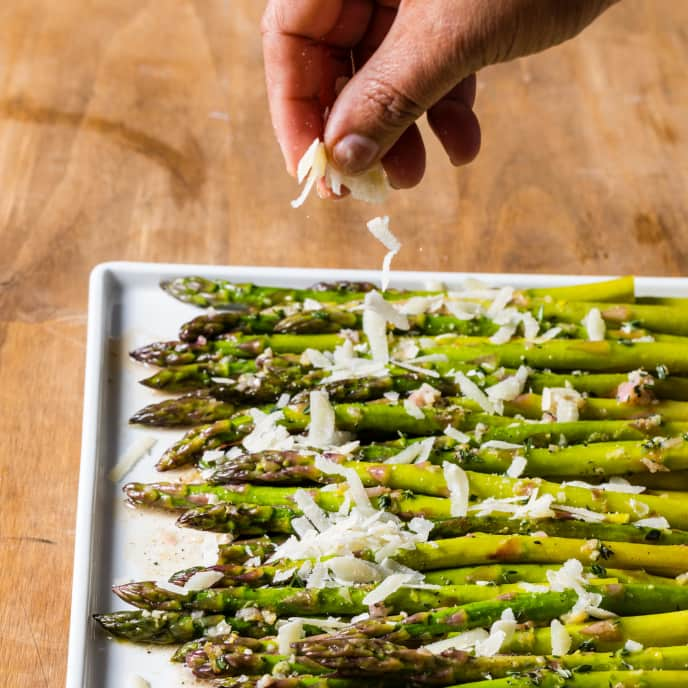Introduction: Embracing the Art of Asparagus Mastery
In the world of culinary delights, few vegetables tantalize the taste buds like crisp, tender asparagus. Its vibrant green hues and subtle sweetness have captured the hearts of food enthusiasts for centuries. Whether gracing salads, roasted alongside succulent meats, or sautéed with a touch of garlic, asparagus always manages to elevate any dish. But while the cooking techniques may vary, there’s one method that stands out for its simplicity and effectiveness: baking in foil at 400 degrees Fahrenheit.

Image: www.cathysglutenfree.com
In this comprehensive guide, we’ll delve into the secrets of this remarkable technique, exploring not only the optimal baking time but also the nuances that will transform your asparagus into an irresistible culinary masterpiece. With a touch of culinary alchemy and our expert guidance, you’ll master the art of baking asparagus in foil, leaving your taste buds forever enchanted.
Breaking Down the Science: Unlocking the Secrets of Baking Asparagus
When it comes to baking asparagus in foil, understanding the scientific principles at play is crucial for achieving perfection. Heat, an essential element in any cooking process, plays a significant role in this technique. As the asparagus is enveloped in foil and subjected to the oven’s heat, a transformative process occurs.
The high temperature of 400 degrees Fahrenheit rapidly penetrates the foil barrier, reaching the tender asparagus spears. The combination of heat and moisture triggers a series of chemical reactions, breaking down the vegetable’s cell walls and allowing the natural flavors to bloom. As the internal temperature of the asparagus rises, a remarkable transformation takes place: its sugars caramelize, releasing an exquisite sweetness that dances upon the palate.
But achieving the perfect balance of doneness is a delicate art. Too little cooking time leaves the asparagus undercooked, lacking the tenderness we crave. Conversely, overcooking can rob the spears of their vibrant color and crisp texture, resulting in a less-than-desirable experience.
The Optimal Duration: Unveiling the Culinary Sweet Spot
The question that lingers on every asparagus enthusiast’s mind is, “How long do I bake asparagus at 400 degrees Fahrenheit in foil?” The answer lies in understanding the desired outcome and the thickness of the asparagus spears themselves. Thinner spears, typically found in the springtime harvest, require less baking time than their thicker counterparts.
As a general guideline, here’s the optimal duration for baking asparagus at 400 degrees Fahrenheit in foil:
-
Thin Asparagus Spears (¼-½ inch thickness): 8-10 minutes
-
Medium Asparagus Spears (½-¾ inch thickness): 10-12 minutes
-
Thick Asparagus Spears (¾ inch or greater thickness): 12-15 minutes
It’s important to note that these times are approximate, and slight adjustments may be necessary based on personal preferences and the specific type of asparagus used. To achieve the desired tenderness without overcooking, it’s recommended to start with the shorter cooking time and add a few extra minutes as needed.
Mastering the Technique: A Step-by-Step Culinary Adventure
With the optimal baking time etched in our minds, let’s embark on a culinary journey, transforming fresh asparagus into a delightful treat.
1. The Foundation: Selecting the Right Asparagus
The quality of your asparagus forms the bedrock of this culinary expedition. Opt for fresh, vibrant spears that exhibit a deep green color and firm texture. Avoid any spears with signs of wilting or bruising.
2. Prepping the Asparagus:
Rinse the asparagus thoroughly under cold water to remove any dirt or debris. Pat the spears dry with a clean towel to prevent excess moisture from affecting the baking process. Trim off the woody ends of the asparagus, approximately 1-2 inches from the bottom.
3. Seasoning the Symphony:
In a large bowl, combine the asparagus spears with a drizzle of olive oil, a sprinkle of salt, and a dash of freshly ground black pepper. Toss the asparagus gently but thoroughly to ensure even seasoning.
4. Wrapping in Foil: A Culinary Cocoon
Unveil a large sheet of aluminum foil and place the seasoned asparagus spears in its center. Fold the edges of the foil over the asparagus, creating a sealed packet that will trap moisture and distribute heat evenly.
5. Baking to Perfection: A Culinary Transformation
Preheat your oven to 400 degrees Fahrenheit and place the foil packet on a baking sheet. Refer to the optimal baking times mentioned earlier and set your timer accordingly. During the baking process, the fragrances of caramelized sugars and asparagus will tantalize your senses, hinting at the culinary delight that awaits.
6. Unveiling the Culinary Treasure
Once the timer chimes, remove the foil packet from the oven and carefully open it. The aroma of perfectly baked asparagus will fill the room, promising a taste of culinary heaven.
7. Serving the Star:
Transfer the asparagus to a serving dish and garnish it with your favorite toppings. From a drizzle of melted butter and shavings of Parmesan cheese to a squeeze of fresh lemon juice and a sprinkle of toasted almonds, the toppings will elevate the flavors and create a delightful dance on your palate.

Image: www.americastestkitchen.com
How Long To Bake Asparagus At 400 In Foil
Expert Insights: Unlocking Culinary Mastery
To further enhance your asparagus-baking prowess, let’s delve into the wisdom of culinary experts and glean their insights.
Chef’s Perspective: Precision and Refinement
“When baking asparagus,” advises renowned Chef Emily Jones, “it’s crucial to be precise with the cooking time. Overcooking can diminish its delicate texture and vibrant color, while undercooking leaves it chewy and less flavorful.”
Registered Dietitian’s Insight: Nutritional Symphony
“Asparagus,” explains Registered Dietitian Sarah Carter, “is an outstanding







